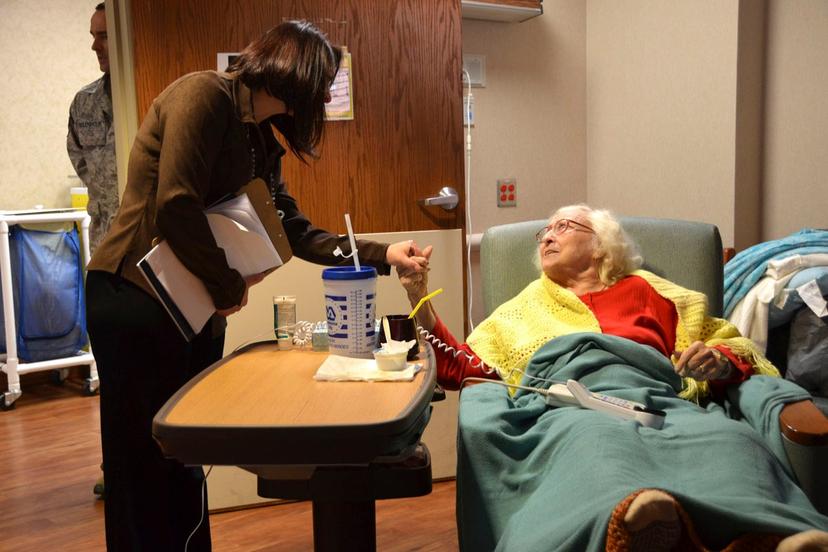Elder Care

Structure
The Bureau of Labor Statistics estimates that in 2018, more than 1.8 million workers were employed in providing services for the elderly and people with disabilities. Of these, the largest single occupational workforce is personal care aides, with 1.2 million workers. They do not provide health care but instead provide companionship and help with daily living activities such as bathing, dressing, doing light housekeeping, shopping, and arranging for transportation. No diploma, degree, or certification is needed to be hired for the low level of skills this job demands, but many employers prefer high school graduates, and criminal background checks are often required. States vary on the type of training they mandate, which ranges from on-the-job training by a manager or more-experienced aide to classes given by a community college or adult-education program.
Home health aides account for 153,210 workers and perform low-level tasks related to health care, such as taking vital signs, seeing that medication is taken, assisting with exercises, and sometimes changing simple dressings, performing massages, or helping with prosthetics. With special training, an aide may help with medical support equipment such as a ventilator. The agencies that they work for receive government funding and therefore are regulated, which means that the aides work under supervision of a medical professional, usually a nurse, keeping records of care given and of any changes in the patient's condition. They are required to demonstrate a certain minimal level of knowledge, usually by completing a short-term training program or passing a certification exam. Some states impose additional requirements.
Nursing homes provide 24-hour medical care, plus meals and assistance with bathing, grooming, dressing, and other physical needs. Nursing homes also often provide social activities at the facility. Some assisted-living facilities, as well, provide some of these services. As a result, these facilities require more highly-skilled health-care workers than the home setting. In 2018, approximately 18,380 registered nurses, 8,690 licensed practical and licensed vocational nurses, and 36,990 nursing assistants provide services for the elderly and people with disabilities. These workers provide care that ranges from giving injections, at the high end of skill and education, to bathing patients, at the low end.
The workforce also includes therapists of various kinds, including physical, occupational, and recreational. Of these, the first requires a doctoral degree, the second a master's, and the third a bachelor's. Licensure is required to practice physical and occupational therapy, and is also required for practicing recreational therapy in some states. Employers tend to prefer certification for all three types of therapists. Although therapists who focus on the elderly most commonly work in residential facilities, some offer these services in the home or in offices. The assistants for these therapists usually have a two-year degree, certification, and sometimes licensure; aides require less education and formal credentials. More than 6,530 therapists serve the elderly and people with disabilities.
Seniors also need counseling help and assistance with getting social services—and their families may be served alongside them. Almost 23,240 counselors and more than 27,480 social workers are engaged in helping seniors deal with mental health, rehabilitation, and other issues. These occupations usually require a master's degree, and licensure is often needed, especially for practicing in clinical settings. Many employers also expect certification.
Depending upon size, elder-care facilities usually have one or several managers to oversee budgets, staff, admissions, care of residents, and planning. Home-care services also need managers. About 2,930 medical and health services managers are focused on care for the elderly and people with disabilities. Licensure requirements depend on the nature of the facility: All states require nursing home managers to be licensed, but not all require licensure of assisted-living managers. Facility managers are supported by administrative workers, who handle clerical, secretarial, receptionist, and similar duties. Assistant managers or clinical managers oversee health-care departments such as nursing and physical therapy, which play a much larger role in nursing homes than in assisted-living facilities.
Hospice care is provided by teams that may include both medical professionals and volunteers. Hospice benefits have been funded by Medicare since 1983. From 2014 to 2017, the number of Medicare-funded hospice programs rose from 4,121 to 4,515, an increase of 9.6 percent. About 1.49 million Medicare beneficiaries received hospice care in 2017, up 4.5 percent from 2016. Some agencies were staffed by volunteers and were not receiving Medicare funding.
